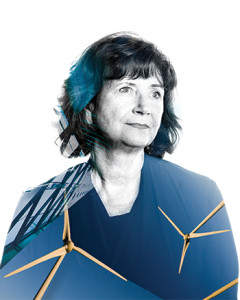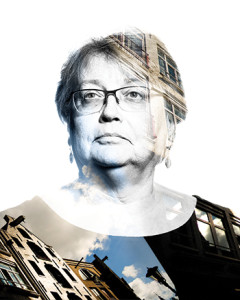Stories by Barbara Dietrich Boose
Photos by Ben Easter
You know someone whose life has been touched by mental illness. Maybe that person is like Des Moines real-estate agent Matthew Connolly, who spent a decade plagued by delusions that left him unable to go to school, work or socialize. Or maybe she’s a colleague like Diane Ramsey, whose bout of crippling depression kept her out of the office for nine weeks. Or perhaps she’s a neighbor like Teresa Bomhoff, whose family members’ struggles with mental illness frightened, isolated and eventually motivated her to speak out.
One in four adults—approximately 57.7 million Americans, 560,000 Iowans and 120,000 people in Greater Des Moines—experience a mental health disorder in a given year. Mental illnesses affect all age groups, ethnicities, and social and economic classes.
“Nobody can escape from mental illness. Each and every family will experience it at some point,” says Adnan Iqbal, M.D., department chair of behavioral health at Broadlawns Medical Center, one of the region’s largest mental health providers. “People shouldn’t think of it as someone else’s problem.”
Indeed, the effects of untreated mental disorders can affect society in tragic ways: The crash of Germanwings Flight 9525, for example, and the mass shooting at Sandy Hook Elementary School in Newtown, Conn., among
other tragedies.
Yet, the negative perceptions attached to mental illness mean the issue is still often ignored, and funding for treatment options is often inadequate. While many health care providers and mental health advocates emphasize that mental disorders are real biological health conditions, like cancer and diabetes, the stigma persists.
Not a Choice
“It’s hard in this country to get away from the attitude that mental illness is a person’s fault, but we’ve learned a lot about childhood traumas, genetics and other conditions and their impact on health,” says Bery Engebretsen, M.D., medical director of Primary Health Care. “It’s not something people choose.”
Darrin Zitterich lives with that reality every day. Growing up in northwest Iowa, Zitterich was 8 when his parents first had him evaluated at the Cherokee Mental Health Institute, but he wasn’t diagnosed until years later. By that time, he was a rage-filled runaway, using cocaine, methamphetamine and other hard drugs.
With drugs, “you think you’re going to run away from your problems,” but you can’t, he says. “Doing drugs was my way of dealing with all the anger.”
Though grateful now to be in treatment, Zitterich and his wife, Dixie, are frustrated by the search to find the right mix of medications to control his bipolar disorder, schizophrenia and anxiety, he says: “People make fun of mentally ill people because they have not walked in our shoes. You think you’ve had a rough life? Try being in my head for a day.”
Need for Services
The Centers for Disease Control and Prevention estimate that only 38 percent of those needing mental health treatment receive appropriate services. According to the National Alliance on Mental Illness (NAMI) Greater
Des Moines, Iowa ranks 44th in the nation for mental health workforce availability, 46th for the number of psychologists and 47th for the number of psychiatrists and number of acute care beds for persons with mental illness.
“There is this magical thinking going on that if we don’t provide mental health services, the problem will just go away,” says Janice Landy, M.D., section chief of behavioral health at Broadlawns. “But as with all things in medicine, early diagnosis and treatment of people with mental illnesses are critically important and more cost-effective than sending them to emergency rooms and jails.”
On average, according to Broadlawns, a person in Polk County waits 120 days to be able to access mental health care services. The medical center’s 30 beds for inpatient mental health services and the 20 beds in its two community homes are full virtually 24/7; its mental health staff provides nearly 47,000 clinic visits and 15,000 community-based visits annually.
Broadlawns is working to raise $37 million in state and private funding and operational savings to expand its inpatient and outpatient mental health facilities and services and create a psychiatric residency program (the state has one such program, at the University of Iowa Hospitals and Clinics). “Expanded facilities would enable us to take care of more patients, offer more services and recruit more psychiatrists to the area,” says Jody Jenner, Broadlawns chief executive officer. “The needs exist.”
Teresa Bomhoff, president of NAMI Greater Des Moines and an ardent lobbyist at the Iowa Capitol when the General Assembly is in session, praises entities like Broadlawns for increasing beds and services for mentally ill patients. But she questions why the state is decreasing beds at its four mental health institutions. She’s upset that Iowa is seeking to turn the administration of its $4.2 billion Medicaid program, which provides health insurance to about 500,000 Iowans, to for-profit managed care companies.
“The goal is to cut costs, but you can’t do that without cutting some people out of services,” she says. “I also tell legislators that when they don’t support a long-term funding formula, it prevents counties and communities from building long-term services. But we need to get people into treatment earlier and give them wrap-around services to help them gain control of their illness. We’ll never get ahead of that without a mental health system, not just services. We are where treatment for cancer was 30 years ago.”
That only steels Bomhoff’s commitment to the cause. She points to the statements on the NAMI Greater Des Moines brochure: “You are not alone. The illness is not your fault. Never give up hope.”
Meeting the Challenges of Mental Illness

Matthew Connolly
Matthew Connolly
Living With Schizophrenia
Matthew Connolly is an affable 41-year-old with an easygoing frankness and a ready laugh, including at himself. Hanging out at a local coffee shop after a morning jog, he mentions that he and his wife, Jodi, recently celebrated their eight-year anniversary and speaks lovingly of their two preschool children. He makes plans with friends to “play hooky” at that afternoon’s Principal Charity Classic golf tournament. You briefly find yourself wishing you could join them, because you’re pretty sure it would be a fun group.
What is harder to fathom is the Matthew Connolly of 20 years ago, the Beaverdale native and Dowling Catholic High School graduate who dropped out of the University of Iowa and roamed from San Diego to Memphis to Atlanta before ending up back in Des Moines, living at the YMCA.
“No one would put me up anymore. I couldn’t hold down a job, couldn’t go to school. I didn’t have a dollar to my name,” he says. “Most of my friends were living under the bridge, because they’d used up their time at the Y.”
Connolly hit rock bottom after getting into a fight that landed him in jail and then in a confined inpatient unit at Broadlawns, where he “didn’t know right from wrong, up from down, left from right.” His psychiatrist advised he get treatment at the University of Iowa Hospitals and Clinics. “That thankfully was the best two weeks that happened to me … because that’s where I was diagnosed and started to make a little bit of a turn for the first time,” he says.
His diagnosis, issued 10 years after its onset, was schizophrenia, a chronic, severe and sometimes disabling brain disorder that affects about 3.19 million Americans, or just over 1 percent of the population. People with the disorder may hear voices, believe others are trying to hurt or control them, or suffer from other delusions. Connolly recalls having intense conversations with people on television or, while he was driving in his car, who were walking on the sidewalk. He also experienced olfactory hallucinations, or smelling things that weren’t there.
“I looked up schizophrenia on the NAMI (National Alliance on Mental Illness) website, and sure enough as I’m reading all these symptoms, I’m like ‘yep, yep, yep.’ I was a believer then,” he says. “If there’s a lesson to be learned, it’s that no one starts to heal unless they have insights into their illness. You have to know, you have to believe that all the signs are there, that you’re sick. You have to understand that you have diabetes or cancer or a mental illness.”
Connolly got to that point during a group therapy session in Broadlawns’ basement. “We were sitting in a circle and I thought one of the guys was doing flips up on the ceiling of the room,” he recalls. “And then all of a sudden I thought to myself, ‘I bet he is not doing flips off the ceiling.’ That was the first time I questioned my delusions.”
Less than a year later, Connolly was symptom-free and working as a foreman at his father’s company, Tom Connolly Homes. Now a real estate agent and “green builder” who serves on the NAMI Greater Des Moines board, he emphasizes the importance of what he calls “five pillars of support”: psychiatry and medications; therapists; his social worker; NAMI and other community supports; and family and friends. He also recently began working with a life coach.
“I’m goal-oriented, career-focused and money-driven a little bit, so it’s fun to review my goals. It keeps me grounded,” he says. He also speaks openly about his illness to groups and to individuals also struggling with mental disorders.
“My No. 1 goal is to show people that recovery from mental illness is totally possible. Have hope,” he says. “The stigma has to go away; it’s an illness. I’m still going to have a successful family life; I’m going to be a great dad and a great husband and be successful in my career regardless of what people think of what I am.”

Diane Ramsey
Overcoming Depression
When clinical depression forced Diane Ramsey to take a nine-week leave of absence from her managerial job, a colleague was convinced she had been on a reality TV program.
“When I came back, one of my direct reports said, ‘I’m dying to know—were you a contestant on ‘Survivor’? It was ironic. I thought, ‘Yes, I am a survivor,’ ” says Ramsey, who then was a manager with Alliant Energy in Cedar Rapids and now is CEO of Iowa Women Lead Change (IWLC). “The company was so supportive of me in getting healthy and also respectful of my privacy.”
She is grateful for her employer’s discretion, but pressures at work likely triggered her depression. “We were going through a significant reorganization. I had to reduce my team by 40 percent; there was a lot of turmoil,” she recalls. “That can be very emotionally draining, especially if you internalize it. Plus I was continuing to push myself.”
Ramsey was serving in volunteer roles as well, adding to her stress. She lost interest in weekend entertaining in her home, which she had loved. “I knew I was not myself. I needed someone to intervene on my behalf,” she says. She checked into a local emergency room, where a physician connected her to a psychiatrist who she says saved her life. She was hospitalized for treatment that included several shock therapy sessions and medication. The experience, she says, changed her.
“Certainly it gave me an appreciation and empathy for others with these issues and for how debilitating they can be,” she says. “It slowed me down a little bit and caused me to really think about my priorities.”
Ramsey, who had no episodes before her depression and has had none in the 11 years since, credits her “very strong network” of family and friends and her current role with IWLC for giving her a positive purpose. “It’s absolutely made a difference in how I want to focus my life,” she says.
But she hasn’t forgotten the lessons she gained from her depression: “Depression and mental illness are still not something people talk about. I’m doing so because I want people to understand it does not have to define you.”

Ben Easter
Managing OCD
Des Moines photographer Ben Easter says he’s always been a perfectionist. His high school class notes were color-coded, detailed with diagrams and revered by his teachers. In his early career as an actor, in movies such as “Pearl Harbor,” he researched his roles, studied acting techniques and learned how to chart a character’s emotional development.
As a preteen, however, his perfectionism had become extreme. “I was making my bed three times a day, but then I would sleep on the floor because I didn’t want to mess it up,” he says. “I remember feeling out of control. It was ridiculous, and I knew it was ridiculous.”
When his parents decided to seek help for their son, Easter was ready. A therapist suggested he read the book “The Boy Who Couldn’t Stop Washing” by psychiatrist Judith Rapoport, who drew upon the experiences of her patients with obsessive-compulsive disorder (OCD) to explore the cleaning, counting, washing, checking and other “pointless rituals” that cripple up to 6 million Americans who have the disorder.
“I remember feeling such relief and gaining a perspective on what it was all about,” says Easter, now 36. “I also realized I was really lucky that I didn’t have it to the degree that other people have it.”
The medication he was prescribed, he says, “was not effective for me—it numbed me out.” What worked better was learning to think about and react to daily situations in ways that defused his feelings of being out of control. He also gained a lifelong love of yoga, which helps him maintain mind-body balance.
“Now I don’t obsess about things,” he says. “When I feel scatterbrained or start to feel anxiety, I know what works for me. I go to yoga, move my body, focus on my breath and then let go.”
Though Easter had a negative experience with medication for OCD, he’s clear that isn’t the case for everyone: “There are people for whom obsessive-compulsive disorder is not going to be a phase. I don’t want people to think that I think you can just do yoga and be OK.”
Easter—who took the photos in this story, including his self-portrait—calls photography his “other yoga.” His approach is influenced by years of being on film sets and working with directors. When the people he’s photographing are nervous, he shares lessons from coping with OCD. “When you are having anxiety about something, if you try to control it and stop it, usually that emotion will win. If you just breathe into it and embrace it, it will go away,” he says. “And any honest emotion is beautiful to see in a photograph.”

The Effect on Families
The stigma of mental illness was painfully, palpably evident at a recent National Alliance on Mental Illness (NAMI) support group meeting for family members. Participants described how their mentally ill loved ones experience “chilling social discrimination,” shame and humiliation that make seeking and navigating treatment extraordinarily difficult.
“As soon as my son was diagnosed, one by one his friends went away,” said one mother. “It breaks your heart to see their social life disappear.”
Parents also worry about having their child labeled as needing special education or themselves labeled as unfit. “Anxiety, guilt, fear and grief affect families. They face the mental wear and tear of helping their child manage and also the fear of telling anyone about it,” says Anne Starr, chief executive officer of Orchard Place, a Des Moines-based organization that serves youths who have mental health and behavioral challenges.
“Parents worry, ‘Did I do this to my child? Will others think I’m a bad parent? Am I a bad parent?’ ” she adds. “For families of children with cancer, we would support them, hold fundraisers for them. But parents of children with mental illnesses often don’t get the same kind of sympathy. Yet (mental illness) is every bit as life-threatening, draining and stressful.”
Also stressful is finding the right help for a mentally ill loved one. Jeffrey Means, Ph.D., a retired Des Moines University associate professor and psychotherapist, counseled suicidal and self-harming clients for years. But when his son Tim began to suffer deep emotional stress, it introduced him in a very personal way to “the stresses and strains faced by families who struggle to support a family member with mental illness, and to a medical system ill-formed, and in many ways ill-equipped, to bring hope and healing to patients and their families,” he says.
Means says forging trusting, collaborative relationships with care providers is critical to people with mental illnesses, something Tim was unable to do. The family sought various treatment approaches, even hospitalizing him in Houston’s inpatient Menninger Clinic for about six weeks. Sadly, he took his own life in 2014.
“Tim was left with a sense he had become someone who was antithetical to all he believed in and held dear. The chasm between what used to be and what now was the case was too vast and insurmountable,” Means says. “He felt very much like he was a burden to others.”
Even figuring out where to start looking for treatment options can be overwhelming. When Kyle and Dan Riley of Elko, Minn., noticed their 17-year-old son Michael exhibiting signs of depression, obsessive-compulsiveness and occasional aggression, they found themselves on a “roller coaster” of consulting “all kinds of doctors and diagnoses,” Kyle Riley says.
The family tried a daily treatment program and weekly home counseling sessions but eventually resorted to hospitalizing Michael for more than three months. During that time, the Rileys called facilities around the state and even the nation to find a residential program for their son. The fact Michael has type 1 diabetes was a deal-breaker for most. Finally, they got a call from Orchard Place in Des Moines. Diagnosed with bipolar disorder, Michael stayed in Orchard Place’s residential treatment facility from early February through early June.
“It’s scary to leave your child, but Orchard Place is great,” Kyle says. “The staff provided great care to Michael, and his doctor right away saw him as a good kid who had a lot of scary things going on.”
Members of Teresa Bomhoff’s family began experiencing mental health issues around the time in 1999 that Dr. David Satcher issued the first-ever U.S. surgeon general’s report on mental health. Based on reviews of more than 3,000 research articles, plus first-person accounts by people afflicted with mental disorders, the report stated that mental health is fundamental to health, and mental disorders are real health conditions.
“I thought, ‘Great, it’s being acknowledged at the surgeon general’s level,’ ” Bomhoff says. “I was wrong.”
After 15 years of dealing with mental illness personally and advocating publicly for its sufferers, there is a weariness about Bomhoff, but don’t mistake that for weakness. The president of the National Alliance on Mental Illness (NAMI) Greater Des Moines facilitates the organization’s support groups and frequently gives presentations on mental illness.
“At the time close members of my family became ill, I didn’t really know anything about mental illness,” she says. “I was disappointed that both medical and mental health professionals didn’t have the time to sit down and talk with me about what was going on, what would happen and how to cope with it. It was very isolating.”
Bomhoff learned about NAMI’s 12-week “family to family” support class and decided to attend. “The class addressed my questions and also questions I didn’t even know to ask,” she says. “It was such a relief to know mental illness is a biological issue, a medical illness, and the behavioral aspects are symptoms. It’s not an intentional thing on the part of the person who’s ill, so there’s no one to blame. That gave me the tools to cope day to day with what my loved ones were going through.”
Getting and Paying for Care
In 2014, the state of Iowa changed how it delivers mental health services, moving from a county-based system to one consisting of 15 regions that range from one to 22 counties each. Polk County is its own region. Services are funded by a variety of sources, including private pay, health insurance, and state and federal funding.
Nationally, the Affordable Care Act (ACA) expanded coverage of mental health and substance abuse services by requiring that most individual and small-employer health insurance plans, including all plans offered through the act’s health insurance marketplace, cover such services. The act prohibits health plans from denying coverage for pre-existing conditions, including mental illnesses.
Despite such victories for those with mental illness, they still face difficulty and discrimination in getting care. According to a recent survey by the National Alliance on Mental Illness (NAMI) of 2,720 individuals with mental illness and their family members, nearly a third of the respondents were denied authorization by insurance companies for mental health and substance abuse care. For ACA plans, denials were nearly twice the rate of other medical care. In addition, barriers exist for coverage of mental health medications, including high co-pays, deductibles and out-of-pocket costs.
In Central Iowa, Polk County Health Services oversees a local network of organizations that provides services to adults with mental illnesses and developmental disabilities, including treatment, employment opportunities and community living support. Services are funded by federal, state and local sources, including a county property tax that generated $14 million annually when it was first levied in the late 1990s, the same amount it provides today.
“It’s not possible to allocate adequate resources toward mental health,” says Polk County Supervisor Robert Brownell. “While our delivery of services in Polk County is really good, it’s almost a two-edged sword, a matter of ‘build it and they will come.’ The better job we do, the more demand there will be, which will be hard to meet if we have to stay at 1998 funding levels.”
Both the lack of funding and lower reimbursement rates for mental health care contribute to the biggest barrier to mental health services, the NAMI survey and local advocates assert: the severe shortage of mental health providers.
“Iowa has a public health crisis in the status of its mental health and disability workforce,” says Teresa Bomhoff, president of NAMI Greater Des Moines. “Best practices in mental health care only work if there’s enough money and enough qualified workforce to support the needs in the system. Iowa has neither.”
When resources are available, those practices work. For example, Eyerly Ball, a nonprofit provider of mental health services in Central Iowa, works with police to deploy a mobile crisis response team to calls involving mental health concerns. Team members provide at-the-scene assessments and, as long as the person isn’t dangerous to himself or to others, they work to connect him to appropriate services rather than send him to the emergency room or jail.
Torry Simmons, R.N., assistant director of crisis services with Eyerly Ball, says of the 1,800 calls the team responds to in Polk County each year, fewer than a third result in hospitalization and fewer than 1 percent in jail time. “Mental illness is not a crime; it’s an illness,” she says.
William Walker also works to provide therapy and access to other services to people with mental illnesses before their situations spiral downward. An outreach social worker and mental health therapist with Primary Health Care, a nonprofit community health center, he spends every Thursday at Central Iowa Shelter and Services, providing talk therapy to clients with mental illnesses.
“I try to help them dig back and dig deep on what got their stressors started, listen to their goals and help them realize what they can do themselves to reach them,” Walker says. “Often, if we can give them services early and hit that hard, we can break them out of the struggles that are holding them back.”
Innovative Program Helps Offenders, Saves Money
About 10 years ago, professionals involved in the Central Iowa judiciary, law enforcement, corrections system and mental health services realized “we all were seeing the same people,” says David Higdon, a program planner for treatment and prevention with Polk County Health Services. “We saw that mental health treatment and the criminal justice system overlap sometimes.”
That’s true nationwide: According to the U.S. Justice Department, more than half of all inmates have a mental health problem. But jails and prisons are costly, ineffective places for people to manage mental disorders. Once they are incarcerated, people with mental illnesses tend to stay longer in jail and are at higher risk of re-arrest than other individuals. In many cases, available resources do little or nothing to assist in their treatment and recovery.
One exception is an innovative mental health jail diversion program in Polk County, launched in 2008. The program helps people with mental illnesses who are arrested get the services they need and, when appropriate, reduce or avoid incarceration.
“If we do the right kinds of diversion program, it’s good for public safety, it’s good for the people affected, and it saves money,” Higdon says. “But we know we’ve got to do it right. We aren’t hug-a-thug people.”
Here’s how the program works: Every morning, anyone arrested in Polk County within the past 24 hours appears before a judge. Tim Larson, team lead for the program, scours a database to determine whether those individuals have used the mental health services of Broadlawns Medical Center or Eyerly Ball, which provides adult mental health outpatient treatment and supported residential services. If they have used services or if they demonstrate a need for mental health services during their arrest or intake assessment, Larson accompanies them to their appearance before the judge.
“That lets me be a support person and also is a cue to the judge that this person is having mental health issues,” he says. After those individuals are released from jail, two case managers keep them connected with mental health and community living services.
The program saves money: From July 1, 2013, through June 30, 2014, the program cost $121,000 but is estimated to have saved $321,000 by reducing subsequent jail days among individuals who were already in the mental health care system when they were booked. It saved an additional $91,620 in reduced jail days among people who are connected to mental health services for the first time.
Help for Veterans
Earlier this year, the mental health jail diversion program expanded by connecting incarcerated veterans to services offered by the Polk County Veterans Affairs Office. These individuals meet with staff members who refer them to needed services and make sure they receive VA benefits. Michael Mortensen, one of four veteran service officers in the Polk County office and a veteran who served two tours in Iraq and a year at Guantanamo Bay, previously worked in the county sheriff’s department, where he began tracking veterans who came through the jail.
“We saw a huge need—six or seven veterans per day,” he says. “We’ve been at war more than 12 years. We owe services back to our veterans. Plus, people need to know the impact of failing to serve veterans has on our economy and judicial system.”
From Feb. 22, 2015, through June 10, 2015, the program assisted 383 veterans. Staffed and funded with existing resources, the program has raised awareness among veterans of the services available to them.
“It’s very hard to get veterans to talk about their mental disease. With this program, I can go to their cell door and talk with them,” Mortensen says. “We focus on getting them service-connected.”
Pilot Program
Another component of the Polk County jail diversion program is a pilot program launched in 2013 with the Iowa Prescription Drug Corp. (IPDC), a nonprofit entity that provides prescription medications to Iowans who can’t afford them. In the pilot, people who need behavioral health medications who are released from jail can receive primary care services and up to 90 days’ worth of those medications at no cost.
“Making sure they get those medications is turning out to be a low-cost approach to reducing recidivism, says IPDC Executive Director Jon-Michael Rosmann.
From March 2013 through October 2014, of the 306 people incarcerated at the Polk County Jail who participated in the medication program, 115, or 37.6 percent, re-offended, compared with a recidivism rate of 71 percent of nonparticipating offenders with behavioral health disorders.
Now supported through the Iowa attorney general’s office, the program is “better for the patient, better for their families, cheaper for the jail and cheaper for the county,” Rosmann says. “It’s a win-win-win for all stakeholders and simply the right thing to do.”
What is Mental Illness?
The American Psychiatric Association defines mental disorders as major disturbances in an individual’s thinking, feelings or behavior that reflect problems in mental function. They are grouped on the basis of their symptoms and when they first appear in life. General categories of mental disorders include the following:
- Anxiety disorders cause people to respond to certain objects or situations with fear and dread. These disorders can include obsessive-compulsive disorder, panic disorders, phobias and post-traumatic stress disorders.
- Behavioral disorders, such as attention deficit hyperactivity disorder, involve a pattern of disruptive behaviors in children that last for at least six months and cause problems in school, at home and in social situations.
- Eating disorders, including anorexia, bulimia and binge eating, involve extreme emotions, attitudes and behaviors involving weight and food.
- Mood disorders, including depression, bipolar disorder and seasonal affective disorder, involve persistent feelings of sadness or periods of feeling overly happy, or fluctuating between extreme happiness and extreme sadness.
- Personality disorders cause extreme and inflexible personality traits that may cause problems at work, in school or in social relationships.
- Psychotic disorders such as schizophrenia bring about a range of symptoms, including hallucinations and delusions.
The Cost of Mental Illness
The National Institute of Mental Health conservatively estimates the total cost associated with serious mental illness, defined as those disorders that are severely debilitating and affect about 6 percent of the adult population, to be over $300 billion per year in disability benefits, health care expenditures and loss of earnings. World Health Organization researchers ranked depression the most costly health condition and predicted it will become the second leading cause of disability worldwide in the next five years.
By the Numbers
You likely know multiple people whose lives have been touched by mental illness. Consider:
- About 1 in 10 children lives with a serious mental or emotional disorder.
- Approximately 90 percent of the 34,000 suicides committed in America per year are related to mental illness.
- The U.S. Department of Veterans Affairs estimates that post-traumatic stress disorder afflicts almost 31 percent of Vietnam War veterans, 20 percent of Iraq War veterans and approximately 10 percent of veterans of wars in the Persian Gulf and Afghanistan.
- Around 40 percent of the individuals incarcerated at the Polk County Jail are on psychotropic medications, used to treat symptoms of mental illnesses. About a third of the people who utilize Central Iowa Shelter and Services have a diagnosed mental illness, and likely many others have yet to be diagnosed.
There’s reason for hope, however: According to the National Alliance on Mental Illness, between 70 and 90 percent of individuals have significant reduction of symptoms and improved quality of life with a combination of pharmacological and psychosocial treatments and supports. Early diagnosis and treatment are key.
Advocating for Broadlawns
A unique advocacy group is helping raise money for Broadlawns Medical Center. Formed in 2011 by Johnny Danos and Connie Wimer, Broadlawns Advocate Circle has raised about $5.7 million of its $10 million goal to support the center’s $37 million expansion of its mental health facilities and services.
In addition, the group is serving as a way to train young professionals to be the next generation of philanthropic leaders. Eight established community leaders, including Charlotte Hubbell, Doug Reichardt and Mary O’Keefe, serve as mentors, and 19 young professionals are the mentees.
Jonathan Brendemuehl, corporate communications manager for Bankers Trust and one of the mentees, says it was “easy to say yes” when he was asked to be a part of the Advocate Circle because “the stigma surrounding mental health and treatment baffles me. … Broadlawns provides critical mental health services, and it’s exciting to work on a campaign that will enhance these services.”
The opportunity to learn from the group’s mentors also attracted him, he says: “Advocating for improved access to quality care alongside some of our community’s most prolific leaders and philanthropists has been an incredibly rewarding experience.”
For more information, go to BroadlawnsFoundationAdvocateCircle.com.








